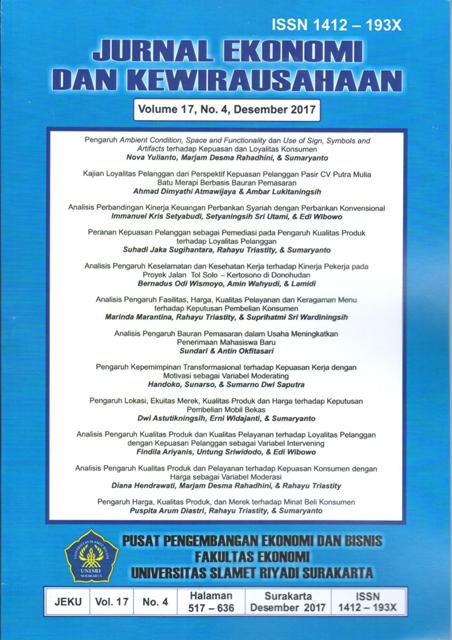ANALISIS PERBANDINGAN KINERJA KEUANGAN PERBANKAN SYARIAH DENGAN PERBANKAN KONVENSIONAL (Studi Kasus pada PT Bank Syariah Mandiri dan PT Bank Mandiri (Persero) Periode 2012 – 2016)
Abstract
The purpose of this research is to analyze financial performance in terms of the
ratio of CAR, NPL, ROA, LDR, BOPO and NIM in PT Bank Syariah Mandiri Period.
2012 - 2016. Analyze financial performance in terms of the ratio of CAR, NPL, ROA,
LDR, BOPO and NIM on PT Bank Mandiri (Persero) 2012 - 2016 Period. Analyzing the
difference of financial performance is reviewed on a CAR, NPL ratio, ROA, LDR, BOPO
and NIM on PT Bank Syariah Mandiri and PT Bank Mandiri (Persero) 2012 - 2016
Period. Research methods using a case study on PT Bank Syariah Mandiri and PT Bank
Mandiri (Persero), the type of data the data used was qualitative and quantitative data,
the source data used the data of skunder. Data analysis technique used is a financial
ratio analysis and test independent sample t-test. The research results obtained
conclusions that: financial performance of PT Bank Syariah Mandiri in the period 2012
- 2016 seen from the CAR, NPL ratio and healthy category entry BOPO, whereas the
ratio ROA entered the category of less healthy and the LDR entry category is not
healthy. The financial performance of PT Bank Mandiri (Persero) in the period of 2012 -
2016 seen from the CAR, NPL ratio, ROA, LDR, BOPO and NIM entry of healthy
category. Financial performance comparison test results that PT Bank Mandiri
(Persero) and PT Bank Syariah Mandiri as seen from the CAR, NPL, ROA, LDR, BOPO
and NIM, there is a significant difference
Keywords: CAR, NPL, ROA, LDR, BOPO, NIM
Downloads
Published
Issue
Section
License
Authors who publish this journal agree to the following terms:
- Authors retain copyright and grant the journal right of first publication with the work simultaneously licensed under a Creative Commons Attribution License that allows others to share the work with an acknowledgement of the work's authorship and initial publication in this journal.
- Authors can separately make additional contractual arrangements for non-exclusive distribution published by the journal (e.g., publish it in a book), with an acknowledgement of its initial publication in this journal.
- Authors are allowed and encouraged to send their work via online (e.g., in the institutional repositories or their website) after published by the journal.









